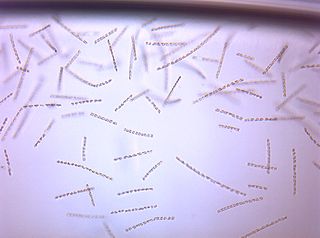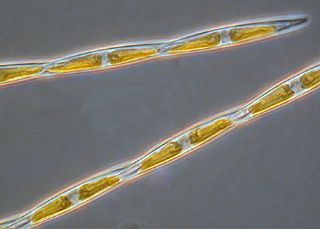
Chaetoceros is a genus of diatoms in the family Chaetocerotaceae, first described by the German naturalist C. G. Ehrenberg in 1844. Species of this genus are mostly found in marine habitats, but a few species exist in freshwater. It is arguably the common and most diverse genus of marine planktonic diatoms, with over 200 accepted species. It is the type genus of its family.
Craticula is a genus of diatom that lies on or in the top layers of sediments in the freshwater to brackish water environments it inhabits. In addition to frustule morphology the genus differs from closely related species by its sexual reproduction and movement in response to light.

Bacillariaceae is a family of diatoms in the phylum Heterokontophyta, the only family in the order Bacillariales. Some species of genera such as Nitzchia are found in halophilic environments; for example, in the seasonally flooded Makgadikgadi Pans in Botswana.

Pseudo-nitzschia is a marine planktonic diatom genus that accounts for 4.4% of pennate diatoms found worldwide. Some species are capable of producing the neurotoxin domoic acid (DA), which is responsible for the neurological disorder in humans known as amnesic shellfish poisoning (ASP). Currently, 58 species are known, 28 of which have been shown to produced DA. It was originally hypothesized that only dinoflagellates could produce harmful algal toxins, but a deadly bloom of Pseudo-nitzschia occurred in 1987 in the bays of Prince Edward Island, Canada, and led to an outbreak of ASP. Over 100 people were affected by this outbreak after consuming contaminated mussels; three people died. Since this event, no additional deaths have been attributed to ASP, though the prevalence of toxic diatoms and DA has increased worldwide. This anomaly is likely due to increased awareness of harmful algal blooms (HABs) and their implications for human and ecosystem health.

Amphora is a major genus of marine and freshwater diatoms. With over 1000 species, it is one of the largest genera of diatoms. These diatoms are recognized by their strongly dorsiventral frustules, which means that their ridges lie close to the ventral margin of the valve, and their girdle is much wider on the dorsal side.

Laurencia is a genus of red algae that grow in temperate and tropical shore areas, in littoral to sublittoral habitats, at depths up to 65 m (213 ft).

The Cymbellaceae are a diatom family in the order Cymbellales.

Eunotiaceae is a family of diatoms in the order Eunotiales that includes the following genera:
Eucocconeis is a genus of diatoms belonging to the family Achnanthidiaceae.

Adlafia is a genus of diatoms belonging to the family Anomoeoneidaceae.
Chamaepinnularia is a genus of diatoms belonging to the family Naviculaceae.

Diploneis is a genus of diatoms belonging to the family Diploneidaceae.

Gomphonema is a genus of diatoms belonging to the family Gomphonemataceae.

Melosira is a genus of diatoms belonging to the family Melosiraceae.










